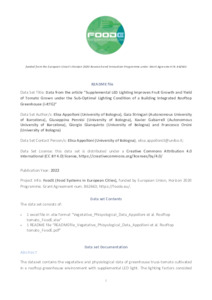Appolloni, Elisa
(2022)
Data from the article "Supplemental LED Lighting Improves Fruit Growth and Yield of Tomato Grown under the Sub-Optimal Lighting Condition of a Building Integrated Rooftop Greenhouse (i-RTG)".
University of Bologna.
DOI
10.6092/unibo/amsacta/7601.
[Dataset]
Full text disponibile come:
![[thumbnail of Data used in the article. Appolloni, E., Paucek, I., Pennisi, G., Stringari, G., Gabarrell Durany, X., Orsini, F., & Gianquinto, G. (2022). Supplemental LED lighting improves fruit growth and yield of tomato grown under the sub-optimal lighting condition]](https://amsacta.unibo.it/style/images/fileicons/other.png) |
Foglio di Calcolo (Data used in the article. Appolloni, E., Paucek, I., Pennisi, G., Stringari, G., Gabarrell Durany, X., Orsini, F., & Gianquinto, G. (2022). Supplemental LED lighting improves fruit growth and yield of tomato grown under the sub-optimal lighting condition)
Licenza: Creative Commons: Attribuzione 4.0(CC BY 4.0)
Download (29kB)
|
![[thumbnail of ReadMe file of dataset from the article "Supplemental LED Lignting Improves Fruit Growth and Yield of Tomato Grown under the Sub-Optimal Lighting Condition of a Building Integrated Rooftop Greenhouse (i-RTG)"]](https://amsacta.unibo.it/7601/9.hassmallThumbnailVersion/READMEfile_Vegetative_Phisyological_Data_Appolloni%20et%20al.%20Rooftop%20tomato_FoodE.pdf)  Anteprima |
Documento di testo(pdf) (ReadMe file of dataset from the article "Supplemental LED Lignting Improves Fruit Growth and Yield of Tomato Grown under the Sub-Optimal Lighting Condition of a Building Integrated Rooftop Greenhouse (i-RTG)")
Licenza: Creative Commons: Attribuzione - Condividi allo stesso modo 4.0 (CC BY-SA 4.0)
Download (223kB)
| Anteprima
|
Abstract
The metabolism of a building can be connected to a rooftop greenhouse, exchanging energy, water and CO2 flows, therefore reducing emissions and recycling cultivation inputs. However, integrating a rooftop greenhouse onto a building requires the application of stringent safety codes (e.g., fire, seismic codes), to strengthen and secure the structure with safety elements such as thick steel pillars or fireproof covering materials. These elements can shade the vegetation or reduce solar radiation entering the rooftop greenhouse. Nevertheless, application of additional LED light can help to overcome this constraint. The present study evaluated supplemental LED light application in an integrated rooftop greenhouse (i-RTG) at the ICTA-UAB research institute, located in Barcelona (Spain), for tomato cultivation (Solanum lycopersicum cv. Siranzo). The experiment explored the effects of three LED lighting treatments and a control cultivated under natural light only (CK). Applied treatments, added to natural sunlight, were: red and blue (RB), red and blue + far-red (FR) for the whole day, and red and blue + far-red at the end-of-day (EOD), each for 16 h d−1 (8 a.m.–12 a.m.) with an intensity of 170 µmol m−2 s−1. The results indicate that LED light increased the overall yield by 17% compared with CK plants. In particular, CK tomatoes were 9.3% lighter and 7.2% fewer as compared with tomatoes grown under LED treatments. Fruit ripening was also affected, with an increase of 35% red proximal fruit in LED-treated plants. In conclusion, LED light seems to positively affect the development and growth of tomatoes in building integrated agriculture in the Mediterranean area.
Abstract
The metabolism of a building can be connected to a rooftop greenhouse, exchanging energy, water and CO2 flows, therefore reducing emissions and recycling cultivation inputs. However, integrating a rooftop greenhouse onto a building requires the application of stringent safety codes (e.g., fire, seismic codes), to strengthen and secure the structure with safety elements such as thick steel pillars or fireproof covering materials. These elements can shade the vegetation or reduce solar radiation entering the rooftop greenhouse. Nevertheless, application of additional LED light can help to overcome this constraint. The present study evaluated supplemental LED light application in an integrated rooftop greenhouse (i-RTG) at the ICTA-UAB research institute, located in Barcelona (Spain), for tomato cultivation (Solanum lycopersicum cv. Siranzo). The experiment explored the effects of three LED lighting treatments and a control cultivated under natural light only (CK). Applied treatments, added to natural sunlight, were: red and blue (RB), red and blue + far-red (FR) for the whole day, and red and blue + far-red at the end-of-day (EOD), each for 16 h d−1 (8 a.m.–12 a.m.) with an intensity of 170 µmol m−2 s−1. The results indicate that LED light increased the overall yield by 17% compared with CK plants. In particular, CK tomatoes were 9.3% lighter and 7.2% fewer as compared with tomatoes grown under LED treatments. Fruit ripening was also affected, with an increase of 35% red proximal fruit in LED-treated plants. In conclusion, LED light seems to positively affect the development and growth of tomatoes in building integrated agriculture in the Mediterranean area.
Tipologia del documento
Dataset
Autori
Parole chiave
light emitting diode; rooftop greenhouse; building-integrated agriculture; Solanum lycopersicum; chilling injury
Settori scientifico-disciplinari
DOI
Data di deposito
02 Apr 2024 08:33
Ultima modifica
02 Apr 2024 11:05
Nome del Progetto
Programma di finanziamento
EC - H2020
URI
Altri metadati
Tipologia del documento
Dataset
Autori
Parole chiave
light emitting diode; rooftop greenhouse; building-integrated agriculture; Solanum lycopersicum; chilling injury
Settori scientifico-disciplinari
DOI
Data di deposito
02 Apr 2024 08:33
Ultima modifica
02 Apr 2024 11:05
Nome del Progetto
Programma di finanziamento
EC - H2020
URI
Statistica sui download
Statistica sui download
Gestione del documento:



 Login per gli autori
Login per gli autori



